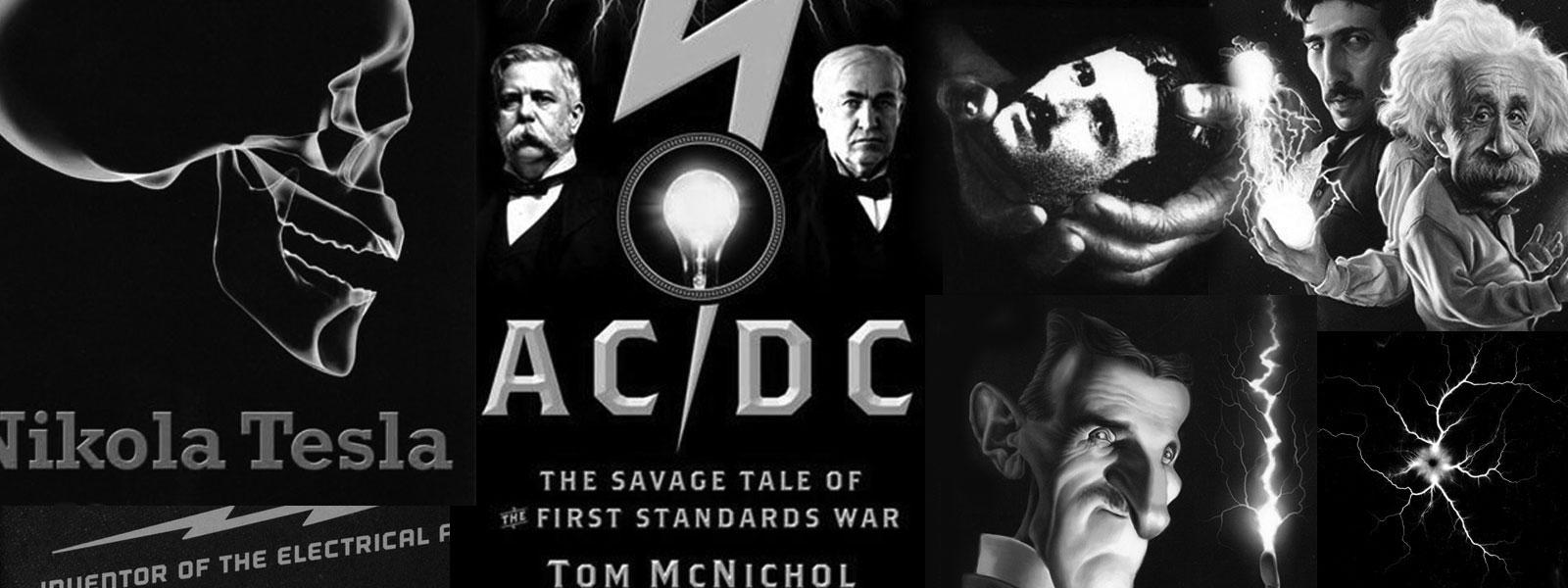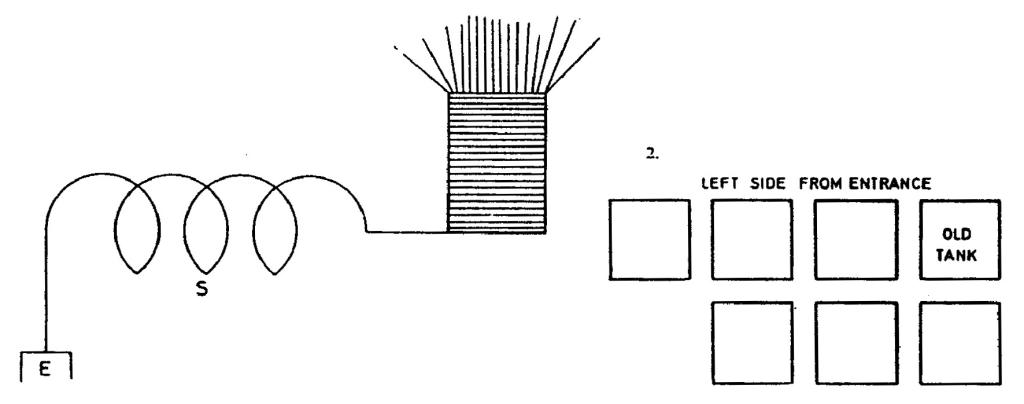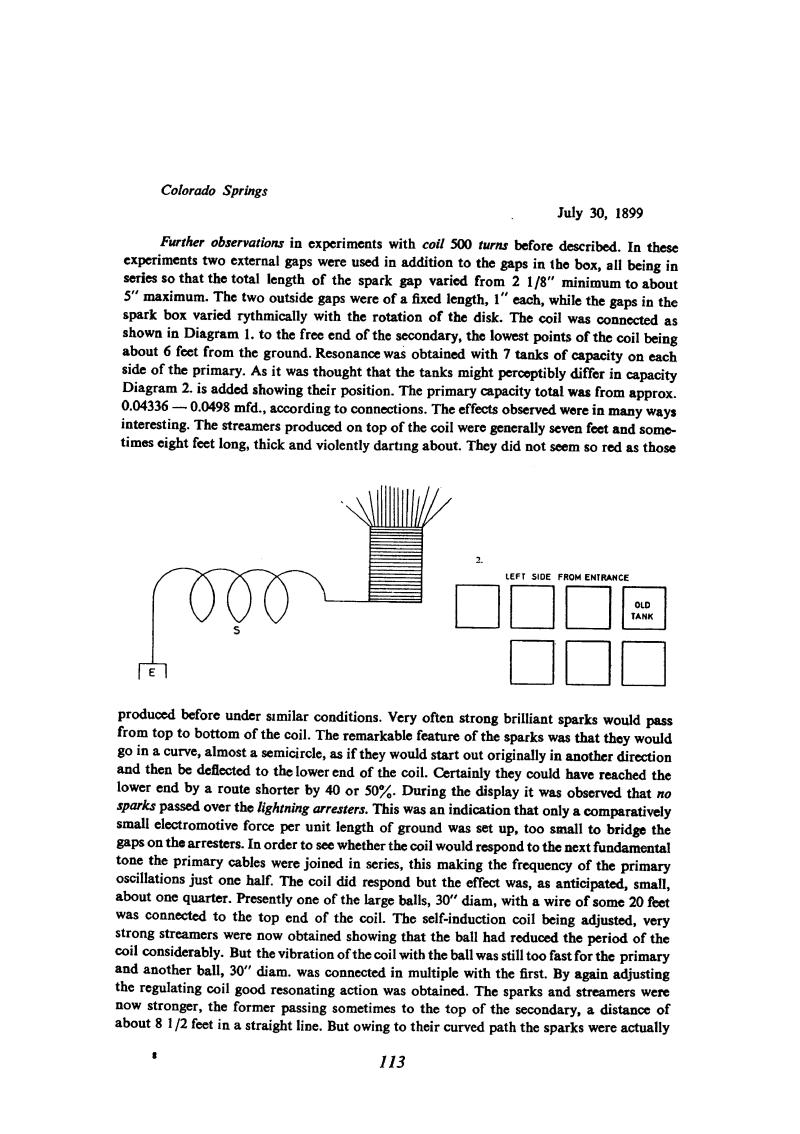
Nikola Tesla Books
Colorado Springs
July 30, 1899
Further observations in experiments with coil 500 turns before described. In these experiments two external gaps were used in addition to the gaps in the box, all being in series so that the total length of the spark gap varied from 2 1/8" minimum to about 5" maximum. The two outside gaps were of a fixed length, 1" each, while the gaps in the spark box varied rhythmically with the rotation of the disk. The coil was connected as shown in Diagram 1. to the free end of the secondary, the lowest points of the coil being about 6 feet from the ground. Resonance was obtained with 7 tanks of capacity on each side of the primary. As it was thought that the tanks might perceptibly differ in capacity Diagram 2. is added showing their position. The primary capacity total was from approx. 0.04336 - 0.0498 mfd., according to connections. The effects observed were in many ways interesting. The streamers produced on top of the coil were generally seven feet and sometimes eight feet long, thick and violently darting about. They did not seem so red as those produced before under similar conditions.
Very often strong brilliant sparks would pass from top to bottom of the coil. The remarkable feature of the sparks was that they would go in a curve, almost a semicircle, as if they would start out originally in another direction and then be deflected to the lower end of the coil. Certainly they could have reached the lower end by a route shorter by 40 or 50%. During the display it was observed that no sparks passed over the lightning arresters. This was an indication that only a comparatively small electromotive force per unit length of ground was set up, too small to bridge the gaps on the arresters. In order to see whether the coil would respond to the next fundamental tone the primary cables were joined in series, this making the frequency of the primary oscillations just one half. The coil did respond but the effect was, as anticipated, small, about one quarter. Presently one of the large balls, 30" diam, with a wire of some 20 feet was connected to the top end of the coil. The self-induction coil being adjusted, very strong streamers were now obtained showing that the ball had reduced the period of the coil considerably. But the vibration of the coil with the ball was still too fast for the primary and another ball, 30" diam. was connected in multiple with the first. By again adjusting the regulating coil good resonating action was obtained. The sparks and streamers were now stronger, the former passing sometimes to the top of the secondary, a distance of about 8 1/2 feet in a straight line. But owing to their curved path the sparks were actually
113
Tesla: âMethod of intensifying and utilizing effects transmitted through natural mediaâ, U.S. Patent, 685 953, Nov. 5, 1901, Appl. June 24, 1899, P-297.
July 30
To try and verify his hypothesis about the rejection of harmonics with appropriate coils, Tesla changed the connection of his âextra coilâ as shown in Figs. 4 and 5. To understand his way of proceeding one must take into account his ideas from 1893(6) concerning the induction of earth currents via an aerial-earth system. However, the standing waves in terms of which he tried to explain the arcing over the lightning arresters cannot be significant at these frequencies.
July 30
Along with the application of new "additional coil" Tesla repeats the experiments with his oscillator and after the usual matching procedure he achieves better results than in previous cases. He obtains sparks of approximately 2.5 meters in length. He considers the conductor curve radius influence on the current streamers appearance phenomenon. On this occasion he emphasizes the importance of current streamers elimination which create the losses and reduce the system efficiency for wireless transmission.
The conclusion on current streamers is correct, but that could not be said for the explanation of the advantage of having an elevated wire with capacitive loading in relation to the same wire without loading. In consideration of transitional events in oscillator circuits, he again separates the coil validity factor influence from the excitation influence (sudden current changes) at the instance of spark appearance and interruption in an oscillator arcing device.
Commenting on the non-existence of sparks on lightning arresters, he makes the judgment that the reasons for this are the high harmonics blocked by corresponding coils and they do not react to ground. In an effort to check his assumption, he changes "additional coil" connecting method according to Figure 4 and obtains a new oscillator configuration. Unfortunately, the experiment description is not complete, and it is not known whether he made some changes in the primary circuit in order to achieve, with connections in Fig. 3, 4, the maximum oscillator effect. The difference between connections in Figs. 4, 5 is that in the first the grounded sphere is excited via "additional coil", and in the second only the grounded sphere is excited. It is possible that the sphere system without additional coil oscillates at a higher frequency, but one cannot draw reliable conclusions without a deeper analysis.
The same day he devoted some time to design and calculation of a high frequency transformer for a high receiver. He intended to use it for operation with a "fast vibrating" system (probably as the one in Fig. 5). As far as design is concerned, the receiver was probably similar to the one of July 28.
As during many previous days, Tesla, this time as well, studies several problems. He found the time to study also the variation of voltage on supply transformer primary at various capacitive loadings. He found the voltage variation that points to the transformer impedance increase, although the secondary reactive impedance was being reduced.


